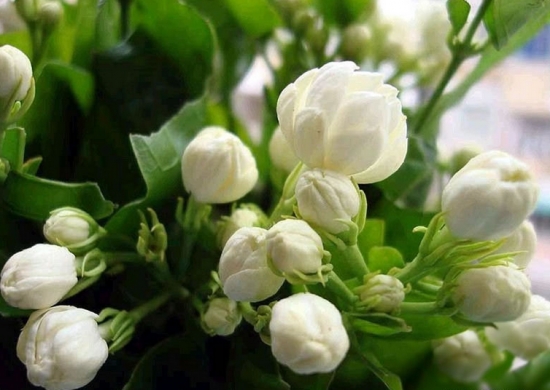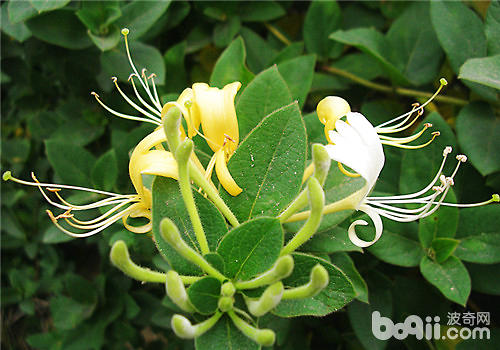How do jasmine flowers reproduce
How to reproduce jasmine, family propagation of jasmine can be done by ramet, striping and cuttage.
(1) ramet. If the cultivated jasmine is clustered and has more than 4 or 5 branches, it can be combined with changing pots in spring. Each tree should have 2 or 3 branches, and if the original plant has few branches, one branch with exuberant growth can be separated separately. When ramet, cut it with a branch shears or a sharp knife and plant it in two pots.
(2) pressing strip. From May to June every year, the branches with full growth and length of 40cm to 50cm are selected and buried in the soil at a depth of 5cm. The embedded branches should have 1cm and 2 leaf nodes, and cut several places with a knife. After more than a month to take root, more than two months on the basin, let it continue to grow in the basin, to the second spring when the basin is planted. The above two propagation methods have high survival rate and fast mature plants, but the number of reproduction is small.
(3) cutting. Cutting jasmine is easy to survive, and it can be cut at any time as long as the temperature is above 20 ℃. Under domestic conditions, it is generally carried out in April combined with pruning. Select sturdy branches, cut 3-4 leaf nodes, about 10 cm long, cut off the lower leaves, leaving only the upper two leaves. When the branch is cut, it is 0.5 cm from the upper leaf node and 0.3 cm from the lower leaf node. After cutting the branches, use vermiculite or sand as the substrate, according to the number of cuttings, choose the right size flowerpot for cutting.
If you choose a flowerpot with a height of 30 centimeters, install the substrate to 3 places, cover it with glass after cutting, for easy management, and can also be protected by transparent plastic bags. Cuttings 3 to 5, can be used in a small basin, with a large glass bottle or glass buckle, and then gradually see the light, and should pay attention to ventilation. After more than one month, the new root grows, and it can be planted in the basin in two months. Flowerpots with a diameter of 20 cm can plant 4-5 plants, and flowers can be seen in that year. The above is an introduction to how to reproduce jasmine flowers.
How to propagate Jasmine (Secret Book of cutting Propagation of Jasmine)
How to propagate Jasmine (Secret Book of cutting Propagation of Jasmine)
Jasmine is a kind of flower that everyone often raises. There used to be a lot of jasmine in my family, but now I have no time to raise it when I work outside.
To say how to reproduce jasmine, generally use two methods of cutting and striping, but the use of crimping is relatively less, at present, the more popular way of propagation of jasmine is cutting, and the survival rate is high, the number of reproduction is large.
Next, let's take a look at the jasmine cutting secrets of senior flower friends:
The main results are as follows: (1) Jasmine has the best choice of annual flowering branches, the green branches are better, and the yellow and gray branches are aging and the quality of new buds is poor.
(2) the branches are trimmed into two nodes, the lower part of the petiole is removed and required to be cut into an oblique shape, and the upper leaves are cut in half. (3) fill the transparent plastic with yellow sand as the base soil, and cut a small cross at the bottom of the cup to facilitate water seepage. Plastic cup cuttings are easy to observe the sprouting of new roots in the lower branches and transplant after survival.
Details of the specific steps:
1. Put the yellow sand into a used disposable plastic cup. A small drain hole is tapered at the bottom of the cup to facilitate drainage. First, a small hole is pre-inserted with a thin stick (bamboo chopsticks) in the yellow sand, then the jasmine cuttings are cut into the sand in time, pressed with your fingers and watered thoroughly, and placed in a ventilated place where you can not see the sun (that is, where you can see the light, not the sun). Be sure to pay attention to regular watering, yellow sand leaching performance is excellent. It is convenient for the lower part of the cuttings to nodulate and take root (whether the cuttings take root or not can be observed by an one-time transparent plastic cup. It takes about 40 days to root and survive. Pay attention to only one cuttage per cup.
2. Generally, when pruning, the flowering and robust branches of the year are used, and the two sections are a cutting. the upper and lower directions of the axillary buds must be distinguished, and the axillary buds must not be cut down as cuttings, the lower petiole of the cuttings should be cut off, and the lower part of the branch should be slightly cut into an inclined shape. the petiole leaves should be retained on the branches, and half of the leaves should be cut off to control them to absorb water, which is beneficial to the germination of axillary buds. Do not touch the cuttings after sprouting axillary buds, pay attention to watering to observe whether there are whisker roots in the transparent plastic cup. Axillary buds will continue to grow in about 40 days, and individual flower buds will sprout. If there are flower buds, they must be cut off, so that they can not absorb too much nutrients and are not conducive to cuttings rooting. Seeing the white fibrous roots growing in the plastic cup proves that the cuttings are completely alive and can be transplanted to pot soil for maintenance.
3. Jasmine likes to grow in oil sand soil, vegetable garden floating soil (epidermis soil), lotus pond soil, etc. when transplanting, put some tiles at the bottom of the pot, coarse soil (bottom fertilizer can be added in spring transplanting, do not add base fertilizer at other times), which is beneficial to drain water to avoid rotting roots. Take the surviving cuttings out of the cup, retain the root sand ball as far as possible, gently put it into the prepared basin soil, do not shake and add basin soil at the same time, press the added basin soil with your hands and pour water thoroughly, and put it on the site where you can see the sky but not the sun. Maintenance can be maintained in the usual way for a week or so. When watering, you must see dry and wet. You can't always water the fibrous root without a chance to breathe and stretch.
How to propagate jasmine cuttings
Jasmine flowers bloom a lot of beautiful flowers every year, interpreting the fresh style. Jasmine is very common in cities. People have seen it but may not know its name. The ornamental value of jasmine is very high. If you like this kind of small flower, you can try to grow it yourself. Here's how to propagate jasmine cuttings.

How to propagate jasmine cuttings
The propagation of jasmine usually adopts the method of cutting. This method has the advantages of high reproduction coefficient, high survival rate, convenient management and so on. There are two kinds of cuttings: hardwood cuttings and softwood cuttings.
① hardwood cuttings:
Generally at the end of March, when the survival rate of cutting is higher. Cuttings with sturdy, disease-free 2-3-year-old branches are better; the selected branches are cut into 10 cm ~ 15 cm segments, the upper end is cut flat, the lower end is cut into material shape, and inserted in loose, fertile, well-drained basin soil. After cutting, water should be watered frequently within one and a half months (but less water) to keep the soil moist, which is the key to survival.
② softwood cutting:
It is suitable from May to August. At this time, the survival rate of cutting is very high. Insert de can choose the tender green branches that grow in the same year, and the requirements for the branches are: grow healthily, with at least 3 pairs of leaves. The method of ear selection is to cut off two bifurcated branchlets together with a small section of old branches, then separate from the middle into two cuttings, and then cut off a pair of leaves at the base of the cuttings. It should be noted that the cuttings must be used whenever they are cut and should not be stored for too long, otherwise, a large amount of water will be lost and it will be difficult for the cuttings to survive. Within 20-30 days after planting, the leaves were watered 2 ~ 3 times a day, and the cuttings sprouted and rooting after about one month. The seedlings should be planted in different pots during the Qingming Festival and Rain Water of the following year.
Jasmine is a favorite ornament for women. In ancient times, women liked to use it to decorate their hair in a bun; now, some women like to wear it into a bouquet or bouquet with thin lead wire in front of their chest or braids. Jasmine not only has high ornamental value, but also has high economic value. In the international market, jasmine oil has a very high price, the price per kilogram of oil is equivalent to 1 kilogram of gold. Jasmine can also be used to smoke tea, leaves and roots can be used as medicine.
- Prev

How to raise the seedlings of Daphne odora L. in Phnom Penh
(1) choose a good soil. Because Daphne is not tolerant to fertilizer, it is of great significance to increase the content of organic matter in soil. The slightly acidic rotten leaf soil with good permeability and high content of organic matter was mixed evenly with appropriate amount of sand (about 8:1) and used after being exposed to the sun for 2 or 3 days. (2) watering and fertilization
- Next

Planting method of Flos Lonicerae
The planting method of honeysuckle is honeysuckle, also known as honeysuckle, double flower, honeysuckle vine, mandarin duck vine, perennial semi-evergreen winding woody vine, one pedicel and two flowers bloom one after another, first silver-white, then turn golden after 2 days, so silver-white and golden flowers appear on one plant at the same time, and bloom from June to July.
Related
- Fuxing push coffee new agricultural production and marketing class: lack of small-scale processing plants
- Jujube rice field leisure farm deep ploughing Yilan for five years to create a space for organic food and play
- Nongyu Farm-A trial of organic papaya for brave women with advanced technology
- Four points for attention in the prevention and control of diseases and insect pests of edible fungi
- How to add nutrient solution to Edible Fungi
- Is there any good way to control edible fungus mites?
- Open Inoculation Technology of Edible Fungi
- Is there any clever way to use fertilizer for edible fungus in winter?
- What agents are used to kill the pathogens of edible fungi in the mushroom shed?
- Rapid drying of Edible Fungi

